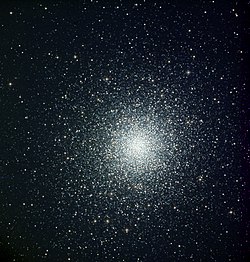\[U\:\approx\:-\frac{GM^{2}}{R}\]
We can think of this collection of particles as a sphere of uniform density. This sphere is made up of many concentric spheres and spherical shells (surfaces) starting from a point at the center of the sphere. Each time a new shell is "layered onto" the existing sphere, the mass and volume of the "proto-sphere" increase until they eventually equal that of the collective sphere. Knowing this, we can calculate the potential energy of each of these smaller spheres of radius r and then integrate from 0 to R in order to find the total potential energy.
 |
| A diagram of the spherical distribution and its "shells" |
\[U\:=\:-\frac{Gm_{1}m_{2}}{r}\]
In order for this to work for our purposes, we need to find two different masses that exert a gravitational force on one another. We can think of the inner mass of each sphere to be \(m_{1}\) and the surface of each of these spheres to be \(m_{2}\). Since the sphere is of uniform density, each sphere will be proportional by volume to the overall mass of the collective sphere, such that
\[m\:=\:\frac{4}{3}\pi r^{3}\rho\]
This equation states that the volume of the sphere times the density \((\rho)\) of the collective sphere will be equal to the mass of the smaller sphere. This makes sense because density is equal to mass over volume. Thus the volume units cancel out and you are left with a fractional mass of the collective sphere. We now have an equation we can use to substitute for \(m_{1}\):
\[U\:=\:-\frac{G(\frac{4}{3}\pi r^{3}\rho)m_{2}}{r}\]
Next we need to find out the mass of the surface of the sphere in terms of r. Earlier, we described the collective sphere as being made up of many spherical shells of uniform density, layered onto one another to create the total sphere. Each of these shells is concentric and has a radius that is dr longer than than the previous shell. Since each subsequent shell equates to an infinitesimal increase in the volume of the forming sphere and thus an infinitesimal increase in mass, we can write the mass of the shell as the derivative of m, dm. By basic calculus, \(dm\:=\:4\pi r^{2}\rho\:dr\). We can then plug this into our equation for potential energy:
\[U\:=\:-\frac{G(\frac{4}{3}\pi r^{3}\rho)(4\pi r^{2}\rho\:dr)}{r}\]
Multiplying this out gives us:
\[U\:=\:-\frac{16}{3}\pi^{2}\rho^{2}Gr^{4}\:dr\]
We now have something we can easily work with for our integral to get the total energy of the collective sphere. Since the collective sphere has a radius of R, we will integrate from \(r\:=\:0\) to \(r\:=\:R\).
\[-\frac{16}{3}\pi^{2}\rho^{2}G\int_0^R r^4\:dr\]
\[-\frac{16}{15}\pi^{2}\rho^{2}GR^5\]
The next step is simplifying the density \((\rho)\) in order to cancel some variables and constants. The density is equal to the mass of the collective sphere over the volume of the collective sphere \(\rightarrow\:\rho\:=\:\frac{M}{V}\:=\:\frac{M}{\frac{4}{3}\pi R^3}\). Thus \(\rho^{2}\:=\:\frac{9M^{2}}{16\pi^{2}R^6}\). Substituting this for the \(\rho^{2}\) in our integrated expression leaves us with
\[U=-\frac{3GM^{2}}{5R}\]
This is approximately the equation we were asked to convince ourselves of at the beginning of this problem. Originally, however the constants had been omitted. This final equation is very useful because it tells us the total potential energy of any spherical distribution, albeit of uniform density. However, we can approximate many celestial and terrestrial objects as spheres and, for the purposes of our class, assume that the density is uniform. As we see later in this worksheet, we can even use this simple equation to calculate the approximate mass of massive star clusters!
 | |
| We can apply our equation to this star cluster (especially because it looks very spherical!) |

Excellent work on this derivation, Carter!
ReplyDelete